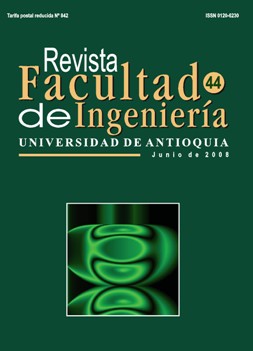Classification methodology and feature selection to assist fault location in power distribution systems
DOI:
https://doi.org/10.17533/udea.redin.18478Keywords:
distribution systems, fault location, power quality, signal characterization, support vectorsAbstract
A classification methodology based on Support Vector Machines (SVM) is proposed to locate the faulted zone in power distribution networks. The goal is to reduce the multiple-estimation problem inherent in those methods that use single end measures (in the substation) to estimate the fault location in radial systems. A selection of features or descriptors obtained from voltages and currents measured in the substation are analyzed and used as input of the SVM classifier. Performance of the fault locator having several combinations of these features has been evaluated according to its capability to discriminate between faults in different zones but located at similar distance. An application example illustrates the precision, to locate the faulted zone, obtained with the proposed methodology in simulated framework. The proposal provides appropriate information for the prevention and opportune attention of faults, requires minimum investment and overcomes the multiple-estimation problem of the classic impedance based methods.
Downloads
References
M. Bollen. Understanding Power Quality Problems: Voltages Sags and Interruptions. IEEE Press.New York. 2000. pp. 5-16.
J. Janos. Fault detection and diagnosis in Engineering Systems. Marcel Dekker, Inc. New York. 1998. pp. 14- 26.
Power System Relaying Committee. IEEE Std C37.114. IEEE Guide for Determining Fault Location on AC Transmission and distribution Lines. 2004. pp. 8-23.
J. Mora, G. Carrillo, B. Barrera. “Fault Location in Power distribution Systems Using a Learning Algorithm for Multivariable Data Analysis”. IEEE Trans. on Power Delivery. Vol. 22. 2007. pp. 1715- 1721. DOI: https://doi.org/10.1109/TPWRD.2006.883021
R. Das. Determining the Locations of Faults in distribution Systems. Ph.D. Dissertation, University of Saskatchewan Saskatoon, Canada, Spring 1998. pp. 16-73
A. R. Warrington, C. Van. “Protective relays. Their theory and practice”. Vol I, Chapman and Hall Ltda. London. 1968. pp. 125-146. DOI: https://doi.org/10.1007/978-1-4684-6459-7
K. Srinivasan, A. St-Jacques. “A new fault location algorithm for radial transmission lines with loads”. IEEE Trans. on Power Delivery. Vol. 8.1989. pp. 1676-1682. DOI: https://doi.org/10.1109/61.32658
J. Zhu, D. Lubkeman, A. Girgis. “Automated fault location and diagnosis on electric power distribution feeders”. IEEE Trans. on Power Delivery. 1997. pp. 801–809. DOI: https://doi.org/10.1109/61.584379
R. K Aggarwal, Y. Aslan, A.T. Johns. “An interactive approach to fault location on overhead distribution lines with load taps”. IEE Developments in Power System Protection. Conference Publication No. 434.1997. pp. 184-187. DOI: https://doi.org/10.1049/cp:19970059
M. Saha, E. Rosolowski. Method and device of fault location for distribution networks. 2002. US Patent number 6,483,435 B2.
M. Son Choi, S. Lee, D. Lee, B. Jin “A new fault location algorithm using ΔIrect circuit analysis for distribution systems”. IEEE Trans. on Power Systems. 2004. pp. 35-41. DOI: https://doi.org/10.1109/TPWRD.2003.820433
J. Mora, L. Pérez, G. Carrillo. “Fault location in power distribution systems using ANFIS nets and current patterns”. IEEE PES Transmission and distribution Conference and Exposition: Latin America. Caracas. 2006, ISBN 1-4244-0288-3. pp. 1-6 DOI: https://doi.org/10.1109/TDCLA.2006.311428
P. Jarventausta, P. Verho. “Using fuzzy sets to model uncertainty in fault location process of distribution networks”. IEEE Trans. Power Delivery. Vol. 9. 1994. pp. 954–960. DOI: https://doi.org/10.1109/61.296278
C. Chien, S. Chen, Y. Lin. “Using Bayesian network for fault location on distribution feeder” IEEE Trans. on Power Delivery. Vol. 17. 2002. pp. 785 – 793. DOI: https://doi.org/10.1109/TPWRD.2002.1022804
Y. Hsu, F. Liu, Y. Chien, J. Liu, J. Lin, H. Yu, R. Kuo. “An expert system for locating distribution system faults” IEEE/PES Summer Meeting. Vol. 1. 1990. pp. 366–372. DOI: https://doi.org/10.1109/61.103760
J. Peng, C. Chien, T. Tseng. “Rough set theory for data mining for fault diagnosis on distribution feeder” IEE Generation, Transmission and Distribution, - Vol. 151. 2004. pp. 689 – 697. DOI: https://doi.org/10.1049/ip-gtd:20040917
Y. Liu, N. Schulz. “Knowledge-based system for distribution system outage locating using comprehensive information”. IEEE Trans. on Power Systems, Vol. 17. 2002. pp. 451–456. DOI: https://doi.org/10.1109/TPWRS.2002.1007917
C. Burges. A tutorial on Support Vector Machines for Pattern Recognition. http://www.kernel-machines.org/. pp. 25-58 Consultada el 15 de abril de 2007.
S. Bernhard, S. Alex. Learning with Kernels Support Vector Machines, Regularization, Optimization and Beyond. The MIT Press, Cambridge. 2002. pp. 24-69
A. Greewood. Electrical Transients in Power Systems. Renselarch Polytechnic Institute. 2nd ed.1991. pp. 56-79
S. Sitharama, E. Cho, V. Phoha. “Foundations of Wavelet Networks and Applications” Chapman and Hall/CRC, CRC Press LLC. 2002. pp. 24-35
A. Oppenheim, S. Willsky, S. Hamid Nawab “Signals and Systems”. International Edition. Prentice Hall. 1997. pp. 45-101.
L. Sousa, J. Martins, V. Fernao. “A network distribution Power System Fault location based on Neural Eigenvalue Algorithm”. 2003 IEEE Bologna Power Tech. pp. 523-531
J. B. Dagenhart. “The 40- Ground-Fault Phenomenon” IEEE Transactions on Industry Applications. Vol. 36. 2000. pp 30-32. DOI: https://doi.org/10.1109/28.821792
H. W. Dommel. “EMTP Theory Book”. 2nd ed. Vancouver. BC: Microtran Power System Analysis Corporation. 1992. pp. 25-102
J. Mora, J Meléndez, J. Bedoya. “Extensive Events Database Development using ATP and Matlab to Fault Location in Power distribution Systems” IEEE PES Transmission and Distribution Conference and Exposition: Latin America. Caracas. 2006.pp. 1-6. DOI: https://doi.org/10.1109/TDCLA.2006.311426
Downloads
Published
How to Cite
Issue
Section
License
Revista Facultad de Ingeniería, Universidad de Antioquia is licensed under the Creative Commons Attribution BY-NC-SA 4.0 license. https://creativecommons.org/licenses/by-nc-sa/4.0/deed.en
You are free to:
Share — copy and redistribute the material in any medium or format
Adapt — remix, transform, and build upon the material
Under the following terms:
Attribution — You must give appropriate credit, provide a link to the license, and indicate if changes were made. You may do so in any reasonable manner, but not in any way that suggests the licensor endorses you or your use.
NonCommercial — You may not use the material for commercial purposes.
ShareAlike — If you remix, transform, or build upon the material, you must distribute your contributions under the same license as the original.
The material published in the journal can be distributed, copied and exhibited by third parties if the respective credits are given to the journal. No commercial benefit can be obtained and derivative works must be under the same license terms as the original work.










 Twitter
Twitter